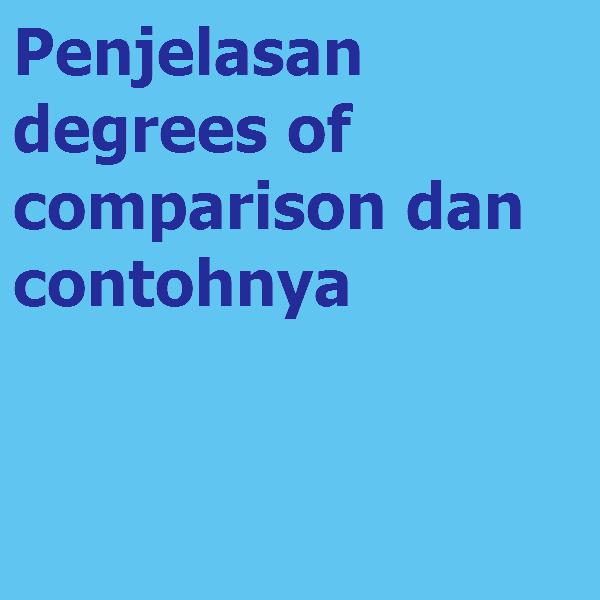
Apa saja jenis atau macam degrees of comparison dalam bahasa Inggris dan bagaimana contoh kalimatnya?
Ada 3 jenis tingkat perbandingan (degress of comparison) dalam bahasa Inggris.
1. Positive degree : ketika kita hanya membicarakan satu orang atau satu hal saja.
Contoh :
- "This house is big." (Rumah ini besar)
- "This flower is beautiful." (Bunga ini indah)
Jadi dalam satu kalimat hanya menyebutkan satu kata benda (dalam hal ini rumah/bunga).
2. Comparative degree : ketika kita membandingkan dua orang atau dua hal.
Contoh :
- "This house is bigger than that one." (Rumah ini lebih besar dari rumah itu)
- "This flower is more beautiful than that." (Bunga ini lebih indah dari bunga itu)
3. Superlative degree : ketika kita membandingkan satu orang/hal terhadap lebih dari dua/lebih orang/hal lainnya.
Contoh :
- "This is the biggest house in this street." (Rumah ini adalah rumah terbesar di jalan ini)
- "This flower is the most beautiful one in this garden." (Bunga ini adalah bunga terindah di taman ini)
Bagaimana dengan aturan tingkat perbandingan untuk adjective yang terdiri dari satu suku kata?
Jawabannya, cukup tambahkan [-er] untuk membentuk comparative degree dan [-est] untuk membentuk superlative degree.
Contoh :
- small / smaller / (the) smallest
- light / lighter / (the) lightest
Untuk adjective dgn 1 suku kata yang berakhiran [-e], cukup tambahkan [-r] untuk comparative & [-st] untuk superlative.
Contoh :
- large / larger / (the) largest
- nice / nicer / (the) nicest
Untuk adjective dgn 1 suku kata berakhiran konsonan-vokal-konsonan, tambahkan konsonan terakhir + [-er] untuk komparative atau [-est] untuk superlative
Contoh :
- fat / fatter / (the) fattest
- big / bigger / (the) biggest
Untuk adjective dengan 2 suku kata, di depan kata tsb tambahkan [more] untuk comparative dan [most] untuk superlative
Contoh :
- boring / more boring / (the) most boring
- pleasant / more pleasant / (the) most pleasant
Untuk adjective dgn 2 suku kata berakhiran [-y], ganti [-y] dengan [-i] lalu tambahkan [-er] untuk comparative & [-est] untuk superlative
Contoh :
- friendly / friendlier / (the) friendliest
- happy / happiest / (the) happiest
Ada adjective dgn 2 suku kata yang menggunakan penambahan [-er] i/ comparative & [-est] untuk superlative sebagai akhirannya.
Contoh :
- narrow / narrower / (the) narrowest
- clever / cleverer / (the) cleverest
- gentle / gentler / (the) gentlest
Jika kalian tdk yakin bentuk mana yg harus digunakan untuk adjective dgn 2 suku kata, maka bs gunakan [more] dan [most]. Karena penggunaan [more] dan [most] sudah semakin banyak diterima untuk adjective dengan 2 suku kata.
Contoh :
- simple / more simple atau simpler / (the) most simplest atau (the) simplest
Namun jangan menggabungkan penggunaan [more/most] dengan [-er/-est]. Pilih salah satu saja.
Untuk adjective dgn 3 suku kata/lebih, di depan kata tambahkan [more] untuk comparative dan [most] untuk superlative.
Contoh :
- beautiful / more beautiful / (the) most beautiful
- interesting / more interesting / (the) most interesting
Di samping semua yang sudah disebutkan di atas, ada juga irregular adjectives yang memang harus kita hafal. 🙂
Contoh :
- good (well) / better / (the) best
- bad / worse / (the) worst
- little / less / (the) least
- much, many / more / (the) most
- far / farther. further / (the) farthest, furthest
- old / older, elder / (the) oldest, eldest
Lalu ada beberapa adjective yang tidak memiliki bentuk positive, hanya comparative dan superlative.
Contoh :
- inner / (the) inmost, innermost
- outer / (the) outmost, outermost
- utter / (the) utmost, uttermost
- upper / (the) upmost, uppermost